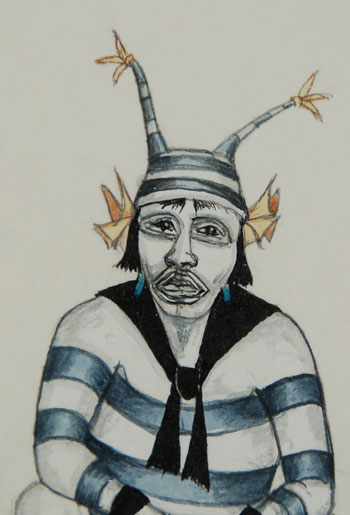Original Painting of Koosa Clowns on Break [SOLD]
+ Add to my watchlist Forward to Friend
Forward to Friend
- Category: Paintings
- Origin: San Ildefonso Pueblo, Po-woh-ge-oweenge
- Medium: watercolor
- Size: 7-1/8” x 10” image; 14-1/8” x 16-3/4” framed
- Item # C3267M
- Price Available On Request

J.D. Roybal (José Disiderio Roybal) was encouraged to paint in 1930 by his day school teacher but did not become productive as a painter until the 1950s, and was most productive in the 1960s decade. He painted primarily in the traditional pueblo style while adding touches that are uniquely his own. Roybal used water-based paints. He developed fine color, excellent detail, small and fine lines, and gesturing figures in his work.

Roybal was particularly fond of painting Koosa (Tewa Clowns). In this image he has pictured the clowns during a rest break. There are two male and one female. The clowns generally torment the Katsina dancers during a ceremony and they are known to eat in excess. They are always gluttons and pictured as such in this painting.
Roybal was a nephew of Alfonso Roybal (Awa Tsireh) and he lived at San Ildefonso Pueblo. His paintings feature fine color, excellent detail and usually humor. The detail of the evergreen bough in the belt of the Koosa and the stitches in the basket are of the finest lines and realistically pictured. Roybal never overlooked the finest details regardless of the complexity or simplicity of a painting.
Condition: appears to be in original condition. A label on verso indicates it was framed with conservation glass
Provenance: from the collection of a family in Arizona.
Recommended Reading: Southwest Indian Painting a Changing Art by Clara Lee Tanner
- Category: Paintings
- Origin: San Ildefonso Pueblo, Po-woh-ge-oweenge
- Medium: watercolor
- Size: 7-1/8” x 10” image; 14-1/8” x 16-3/4” framed
- Item # C3267M
- Price Available On Request



